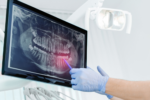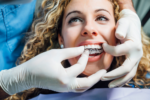
Have you ever wondered how dentists see inside your teeth without opening them up? Well, it’s all thanks to something called dental X-rays! Don’t worry; it’s not as complicated as it sounds. Let’s dive into dental X-rays and uncover what they’re all about.
What Are Dental X-rays?
Think of dental X-rays as special pictures of your teeth, gums, and jawbones. They help dentists see things they can’t see with just their eyes. These X-rays show what’s happening beneath the surface, like a superhero’s X-ray vision!
Why Do Dentists Use X-rays?
Imagine if your dentist in SW Calgary had to guess what was going on inside your teeth without seeing it directly. That wouldn’t be very accurate, right? Dental X-rays help dentists spot problems early, like cavities hiding between your teeth or issues with your jawbone. They’re like secret agents, finding hidden dental enemies!
How Do Dental X-rays Work?
Okay, here comes the science part, but don’t worry; it’s simple. Dental X-rays use a special kind of light called “X-ray radiation.” This light can pass through your skin and gums but gets blocked by your teeth and bones.
When the X-rays hit something dense, like a tooth or bone, they bounce back onto a special film or sensor, creating a picture. It’s like taking a photo, but with invisible light.
Types of Dental X-rays
Just like there are different tools for different jobs, there are different types of dental X-rays, too. Among the most popular dental x-rays near you, a few include the following:
- Bitewing X-rays: The upper and lower back teeth are displayed in a single view in these X-rays. They’re great for spotting cavities and checking how well your teeth fit together.
- Periapical X-rays: These focus on just one or two teeth at a time. They help dentists see the entire tooth, from the crown (the part you can see) to the root (hidden below your gums).
- Panoramic X-rays: Imagine taking a big picture of your entire mouth at once—that’s what panoramic X-rays do. They’re like the selfie stick of dental X-rays.
Are Dental X-rays Safe?
You might be thinking, “But what about all that invisible light? Is it safe?” Do not worry; dental X-rays emit very little radiation, much less than a day in the sun. Plus, dentists take special care to protect you, like covering you with a lead apron to block any stray radiation.
When Do You Need Dental X-rays?
Your dentist won’t just take X-rays for fun—they have a reason. They might need X-rays to:
- Check for cavities hiding between your teeth.
- Look at your tooth roots and jawbone.
- See how your adult teeth are growing.
- Plan for braces or other treatments.
What Happens During a Dental X-ray?
If you ever need a dental X-ray in SW Calgary, here’s what to expect:
- Getting Ready: You’ll wear a heavy apron to protect your body from radiation.
- Taking the X-ray: You’ll bite down on a special holder to keep your teeth still while the X-ray machine does its job. It only takes a few seconds.
- Viewing the Results: After taking the X-ray, your dentist will look at the pictures to see what’s going on inside your mouth. Sometimes, they’ll show you the pictures too.
Wrapping Up
So, there you have it—dental X-rays in a nutshell! They’re like super-powered cameras that help dentists keep your teeth healthy and happy. And remember, if you ever have questions about X-rays or anything else at the dentist’s office, don’t hesitate to ask.
Now, go forth and show off those pearly whites with confidence, knowing that your dentist near you has a secret weapon—dental X-rays—keeping your teeth in tip-top shape! Glamorgan Dental offers expert insights into dental X-rays, which are vital for detecting hidden dental issues early and ensuring optimal oral health for you and your family.







